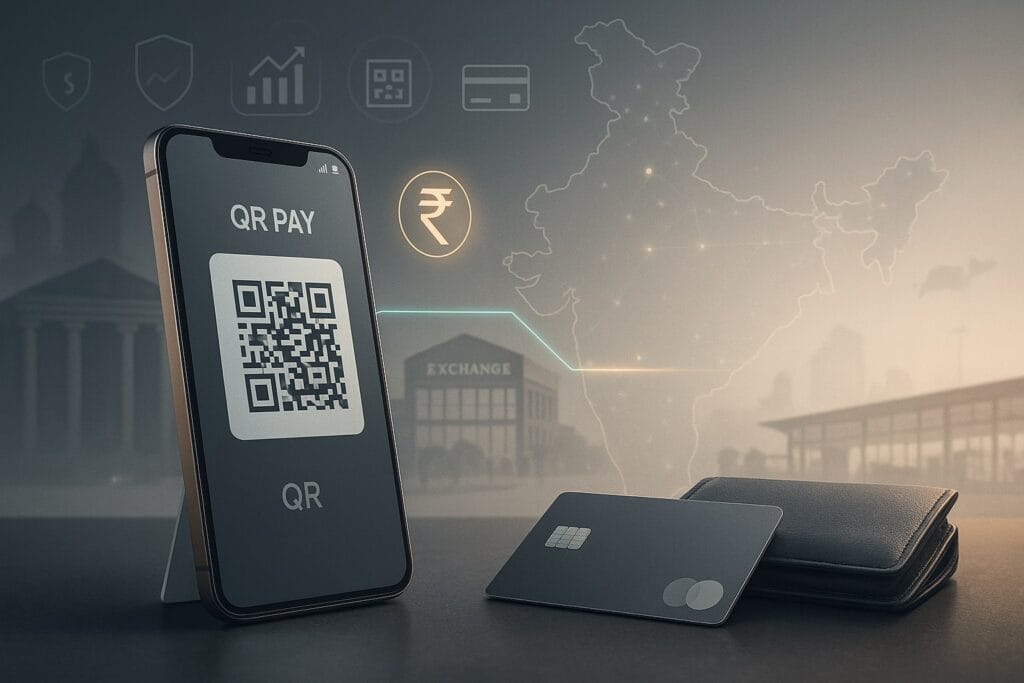Standfirst: Revolut will roll out UPI payments and Visa prepaid cards to a 350,000-person waitlist in India this year, with a bold target of 20 million users by 2030. The prize is huge—but so are the economics and network risks on a market dominated by two domestic giants and governed by tightly-drawn rules.
Table of Contents
ToggleWhat exactly is launching—and why now
At Mumbai’s Global Fintech Fest (Oct 8–9, 2025), Revolut said its India platform will begin with domestic UPI payments and a Visa-branded prepaid card, then open to the wider public after the initial waitlist cohort. The company is investing heavily to comply with India’s data-sovereignty rules—more than £40 million to localise its tech stack—and is explicit about the scale of its ambition: 20 million Indian users by 2030.
This is not a “dip a toe” move. Earlier this year, the Reserve Bank of India (RBI) granted Revolut India full authorisation to issue prepaid payment instruments (PPIs)—wallets and domestic prepaid cards—on top of its existing permissions to run forex and cross-border remittance services as a Category-II Authorised Dealer. That matters: it lets Revolut offer a single in-app experience for domestic UPI spends and international travel money.
The rails: UPI’s scale—and its rules
UPI is the world’s busiest instant-payment system. In August, it processed 20.0 billion transactions worth ₹24.85 trillion; in September it handled 19.63 billion—a dip driven by a shorter month, while daily averages kept rising. That is the system Revolut is joining.
UPI is also a policy instrument. For standard bank-to-bank UPI, the government and RBI have held the merchant discount rate (MDR) at zero, offsetting some provider costs via budget incentives. But for wallet-on-UPI (PPI-based UPI), NPCI allows interchange—typically up to 1.1% above ₹2,000—paid by the merchant side to the PPI issuer. Customers still pay nothing. This nuance shapes revenue and pricing.
Two other UPI changes landed this week that will set expectations for any new app: on-device biometrics to authorise payments, and UPI HELP, an AI support system built on NPCI’s in-house small-language-model to resolve disputes and manage mandates. If Revolut leans into these, it could lower support costs and cut failed-payment friction.
The moat: a near-duopoly and a delayed cap
India’s UPI front-end is effectively a two-horse race. PhonePe and Google Pay together handle roughly 80–83% of UPI volumes; August data put PhonePe near 46% and Google Pay around 35%. A planned NPCI rule to cap any player’s UPI share at 30% was pushed out to December 2026—buying the leaders even more time to entrench. For a challenger, that raises acquisition costs and narrows default-choice shelf space on merchant QR flows.
The economics: can a wallet make money on UPI?
Revolut’s Indian wallet will sit inside RBI’s PPI framework. Two points matter for unit economics:
- Revenue lines: For bank-to-bank UPI transactions, MDR is zero—little to monetise directly. For PPI-on-UPI transactions above ₹2,000, interchange flows to the PPI issuer (i.e., Revolut) from the merchant acquirer. That creates a revenue path for higher-ticket merchant payments—especially online—provided consumers actually pay from the Revolut wallet rather than a linked bank account.
- Costs and compliance: RBI’s rules require PPIs to maintain customer funds in escrow and pay no interest to users on wallet balances; KYC drives limits and features. “Small” (minimum-KYC) PPIs have tight monthly caps and must be upgraded to full-KYC within a set time; full-KYC PPIs unlock transfers and cash-out options. Revolut must also meet 2018 data-localisation requirements: all payments data for India stays in India. These are not optional—and they add operational cost.
Put simply: to monetise, Revolut needs a high share of wallet-sourced UPI spends (not just bank-linked UPI), solid card usage, and cross-sell into fee-bearing services.

The cross-border wedge
Revolut’s global brand promise is “one app for home and travel.” In India, it can combine UPI domestically with Visa prepaid and its existing forex/remittance permissions for international spends and transfers. That offers a neat story for globally mobile users: book travel, spend abroad, settle and move money in-app. It also meets the letter of RBI’s rules, because Revolut built a dedicated India stack to keep domestic payments data on-shore.
The open question is whether UPI’s own cross-border push narrows that edge over time. UPI acceptance is steadily expanding in markets such as the Gulf; Qatar has rolled out QR acceptance at more merchants—making it easier for Indians abroad to pay straight from Indian accounts, without a separate travel wallet. If that coverage grows, “use my Indian UPI” could substitute for a multi-currency wallet for many small-ticket spends.
The super-app trap: feature breadth vs licence reality
Revolut’s European app bundles investing, crypto, savings and more. In India, the launch scope is rightly narrower: payments and cards first, built under PPI, FX and remittance permissions. Anything beyond that—credit lines, brokerage, insurance distribution—requires additional licences or partnerships. RBI also tightened rules to let full-KYC PPIs link to UPI through third-party apps, improving interoperability but not changing the fact that credit on UPI today rides primarily on RuPay credit cards issued by banks, not on PPIs. That is a competitive gap a wallet-led entrant must answer.
The user: who is Revolut really for?
Revolut says it is chasing India’s globally aspirational, digital-native 25–45 segment—people who travel, shop cross-border and want clean FX. That is a sizeable niche, but it is still a niche in a mass UPI market dominated by zero-fee habits and domestic routines. To break out, Revolut must do at least three things well:
- Win the home screen. Indian users already split between two UPI leaders. Revolut needs a reason to open its app first. Instant dispute resolution (via UPI HELP hooks), thoughtful rewards, and a faster, more reliable “scan-and-pay” experience will count more than design gloss.
- Own high-value merchant use-cases. Because interchange on PPI-UPI kicks in above ₹2,000, Revolut should steer users toward categories like travel, electronics and education where ticket sizes justify wallet-sourced payments—and where merchants are less fee-sensitive. (NPCI’s matrix sets different interchange bands by category.)
- Make cross-border effortless. Tight FX pricing is table-stakes; the win is in workflow: in-app rate locks, travel eSIMs, automated GST-compliant expense trails, and fee-clear remittances. The £40 million local tech build only pays back if it turns into visible, low-friction features that locals can’t get from incumbents.
What could go wrong
Customer acquisition cost (CAC). Competing for UPI users at scale is expensive—especially with the market-share cap delayed to 2026, allowing incumbents to keep volume flywheels spinning.
Merchant push-back. Some large merchants have grown used to zero MDR on bank UPI and will resist steering to a wallet flow that attracts interchange above ₹2,000—unless Revolut bundles marketing or better authorisation rates.
Regulatory drift. Delhi has repeatedly signalled that UPI stays free for users; budget incentives for providers have been tweaked and debated. Any change—up or down—affects the margin math for all players, new and old.
Credit on UPI. RuPay credit-on-UPI is gaining traction. If bank-issued credit experiences keep improving, a PPI-first wallet risks being boxed into debit-only behaviours.
What success would look like
A realistic medium-term win state for Revolut in India does not mean dislodging the UPI duopoly. It looks like this:
- High share of wallet-funded UPI in a targeted user base, concentrated in categories where interchange is payable.
- Visa prepaid used habitually for domestic offline spends where card rails beat QR (taps at transit, fuel, offline POS).
- Cross-border as the halo: clean FX, transparent remittances, and merchant acceptance abroad that UPI cannot yet match.
- Reg-tech excellence: airtight data-localisation, fast e-KYC/V-CIP flows, and proactive adoption of NPCI’s new biometric and AI tooling to reduce support cost per ticket.
Bottom line
Revolut is not trying to beat India’s UPI champions at their own game. It is trying to change the game for a specific cohort: globally minded users who want one app for local QR, domestic card, and travel money—delivered with crisp UX and predictable pricing. If it can convert that narrative into habitual, wallet-funded high-ticket UPI spends (where interchange lives), and pair it with meaningful cross-border utility, the maths can work—even in a market that loves free. But if most users default to bank-linked UPI (zero revenue) while incumbents keep the daily coffee and kirana payments, Revolut’s India play will feel like an expensive loyalty programme. The next 12 months—when it onboards its waitlist, hardens its India-only stack and negotiates merchant partnerships—will tell us which way the rails run.












